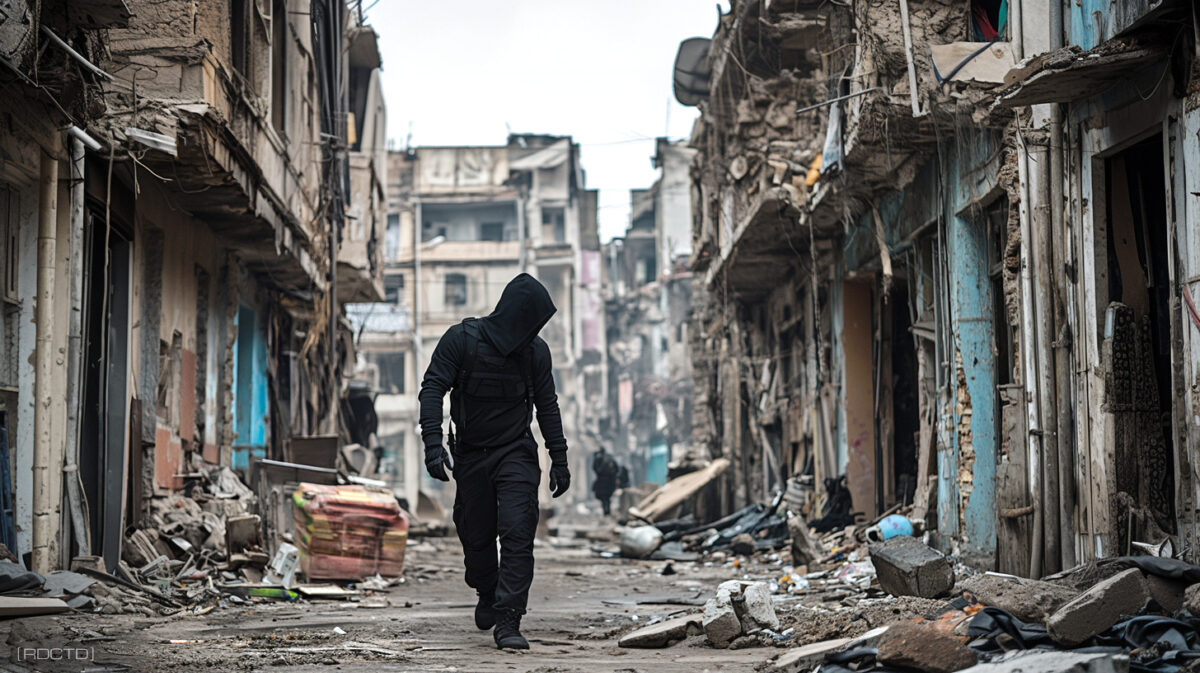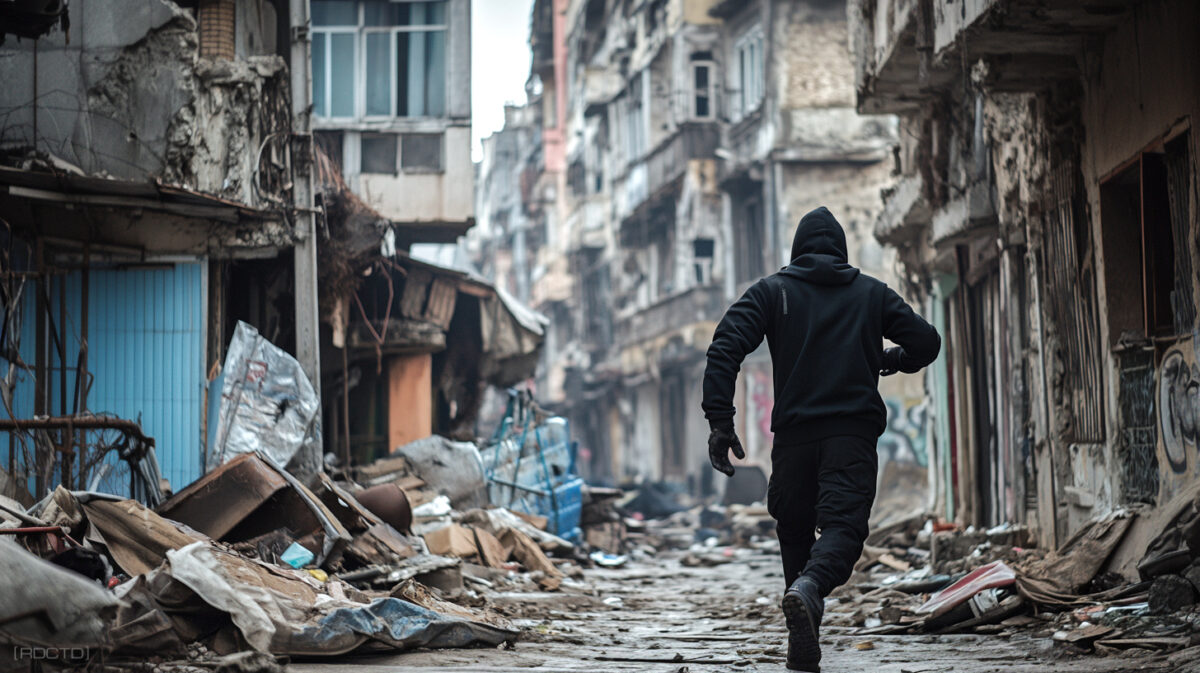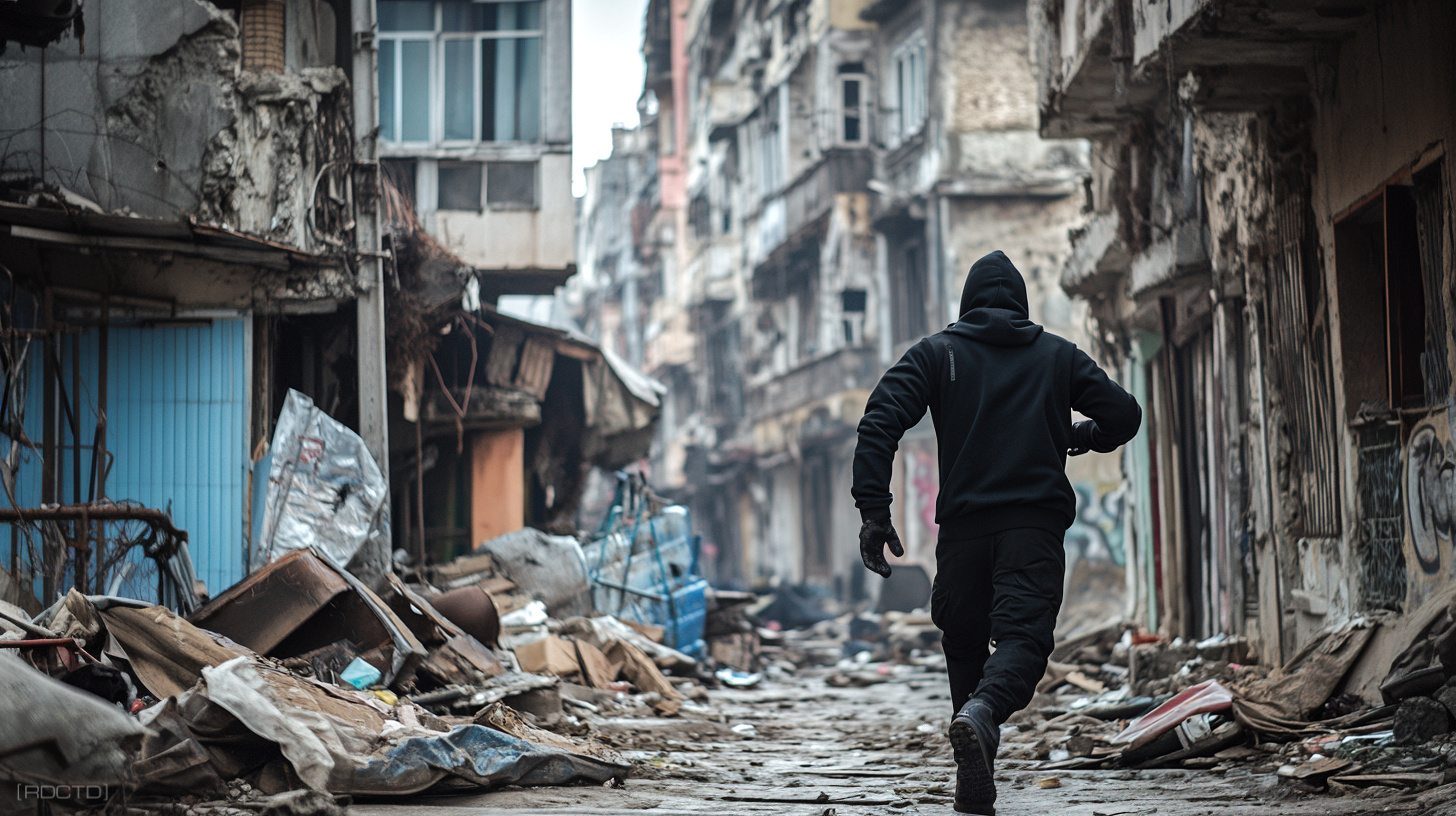 This is a tradecraft guide on how to navigate a city on foot using the concepts and techniques of a covert operative – for general purpose travel, technical personal logistics and operational objectives.
This is a tradecraft guide on how to navigate a city on foot using the concepts and techniques of a covert operative – for general purpose travel, technical personal logistics and operational objectives. ![]()
To be unseen, look like a local. To be untrackable, move like a local.
Moving through an urban environment like a covert operative means more than just getting from point A to point B. It’s about staying unnoticed, understanding the terrain, and always having an escape plan. Whether you’re avoiding surveillance, shaking a tail, or just trying to move efficiently without relying on modern technology, mastering urban navigation is essential.
![]()
![]()
I. THE URBAN TERRAIN
To move like an operative, you need to see a city not as a collection of streets and buildings but as a dynamic environment where every road, structure, and open space can work for or against you. Even without a map or GPS, you can build a mental picture of the area by breaking it down into key elements: main roads, side streets, landmarks, public transit, and security presence.
![]()
Major Roads vs. Side Streets
Main roads are the arteries of a city, offering direct routes but also posing significant risks. They’re often covered by CCTV, crowded with pedestrians, and monitored by law enforcement. These roads are good for quick movement in plain sight but make you more vulnerable to being tracked.
Side streets and alleys, on the other hand, provide concealment and alternative escape routes, but they come with their own challenges. Some may lead to dead ends, have limited exit points, or put you in a more isolated situation where surveillance teams can corner you. A well-trained operative balances both, using main roads for blending in when needed and side streets for discreet movement.
[Key Tactics for Navigating Roads and Streets]
![]()
Landmarks and the Urban Grid
If you don’t have a map, you need to navigate by what’s around you. Landmarks such as skyscrapers, bridges, train stations, or stadiums – help you orient yourself. Even without knowing exact street names, you can use these reference points to move in the right direction.
In cities with grid layouts (like New York or Chicago), understanding the numbering system of streets can help you maintain a sense of direction. Older cities with irregular layouts (like London or Tokyo) require more reliance on memory and observation.
[Tactics For Navigating by Landmarks]
![]()
Public Transportation as a Navigation Tool
Even if you’re traveling on foot, public transportation systems give you a framework for the city’s layout. Subway lines, bus routes, and train stations act as major hubs, usually connecting different districts. These can serve as navigation reference points or, in an emergency, quick exit options.
[Strategic Public Transit Tactics]
![]()
Security Presence and Surveillance Awareness
Cities are filled with security cameras, police patrols, and private security personnel. High-risk areas like government buildings, embassies, and financial districts have heavier surveillance, while residential and commercial areas offer more anonymity.
[Assessment Before Navigating Through an Area]
[Minimizing Exposure to Surveillance]
![]()
Building a Mental Map in Real-Time
If you’re dropped into an unfamiliar city with no map or GPS, start building a mental map immediately:
The better you understand the terrain, the more control you have over your movements. A city is only as confusing as your ability to read it.
![]()
![]()
II. STRATEGIC MOVEMENT
Moving through a city like an operative isn’t just about knowing where to go, it’s about how you move. The goal is to blend in so seamlessly that no one remembers seeing you. Whether you’re evading surveillance, conducting covert reconnaissance, or simply trying to avoid standing out in a foreign environment, mastering low-profile movement is key.
![]()
Blending Into the Environment
Most people walk through cities distracted – staring at their phones, listening to music, or focused on their destination. This works in your favor. The less you deviate from normal behavior, the less you’ll be noticed.
[Key Principles of Staying Unnoticed]
![]()
Using Social Camouflage
Cities are full of groups – commuters, tourists, shoppers, students. Blending into one of these groups makes you less conspicuous.
![]()
How to Avoid Looking Like You’re Being Followed
If you suspect you’re under surveillance, don’t panic. The worst thing you can do is suddenly change direction or start running. Instead, confirm whether you’re being followed and shake the tail naturally.
[Counter-Surveillance Tactics]
If you confirm you’re being followed, don’t lead them to your actual destination. Instead, use a crowded place to break contact or board public transit at the last moment before doors close.
![]()
Avoiding Security & Cameras
Cities today are full of cameras – on buildings, in public transport hubs, and at intersections. Law enforcement and private security teams use facial recognition, AI tracking, and behavioral analysis to flag unusual movement.
[To Avoid Drawing Attention]
[Dodging CCTV & Facial Recognition]
![]()
Reading and Controlling the Crowd
[Using Crowds to Your Advantage]
![]()
Avoiding Choke Points
Some areas naturally restrict movement, making it easier for someone to trap or track you. Avoid:
If you enter a potential trap, have an exit strategy—whether it’s an emergency exit, blending into a group, or using misdirection to escape.
![]()
![]()

![]()
![]()
III. COVER AND CONCEALMENT
Urban environments provide countless opportunities to remain unseen, but only if you know how to use them. Whether avoiding surveillance, escaping a pursuer, or simply staying unnoticed, understanding cover and concealment is key.
In a city, these two often overlap. A parked car might provide both partial concealment and light cover, but a glass bus stop only offers concealment. The ability to identify and use these elements effectively can mean the difference between being seen or disappearing into the urban landscape.
![]()
Using the Environment to Break Line of Sight
The most effective way to disappear is to ensure no one sees you in the first place. This means constantly managing your visibility – breaking line of sight between you and anyone tracking you.
[How to Break Line of Sight While Moving]
Example: If you suspect someone is following you, don’t just turn a corner and sprint away. Instead, turn normally, step into a recessed doorway or behind a parked truck, and let your tail pass without seeing you leave.
![]()
Urban Cover: Protecting Yourself in Hostile Situations
If you’re in a dangerous situation – whether caught in gunfire, riot conditions, or being chased – you need hard cover. Not all cover is created equal. Some materials will stop a bullet, while others will only slow it down.
[Urban Cover Options]
[Poor Cover That Won’t Stop Gunfire]
![]()
Urban Concealment: Staying Hidden in Plain Sight
Concealment alone won’t stop bullets, but it prevents detection – which is often more valuable.
[Best Concealment Options in a City]
![]()
Moving Through Buildings & Structures
Cities are full of structures that can be used to conceal movement, shake surveillance, or evade threats.
[Shopping Centers, Hotels, and Office Buildings]
These locations often have multiple exits and can act as temporary cover. However, many have security cameras and personnel monitoring activity.
[/ihc-hide-content]
![]()
Underground & Rooftop Routes
Many cities offer hidden movement options above and below street level (URBEX).
[Subways, Tunnels, and Parking Garages]
[Rooftops and Fire Escapes]
![]()
Advanced Concealment Tactics
[Disappearing in Plain Sight]
Sometimes, the best way to conceal yourself isn’t by hiding, it’s by blending.
[Using Disguises Subtly]
Full disguises aren’t always necessary. Small changes – like putting on headphones, pulling up a hood, or carrying a shopping bag – can make you look like a different person.
If you need to disappear quickly, duck into a thrift store, buy a cheap shirt, and change your look.
![]()
![]()
IV. ESCAPE AND EVASION
No matter how well you plan, there’s always a chance you’ll need to escape – whether from surveillance, hostile individuals, or an unfolding emergency. An operative never moves through a city without knowing how to get out fast. Mastering escape routes and evasion means thinking ahead, using terrain to your advantage, and ensuring you’re never cornered.
![]()
Building Your Escape Plan: The Three-Route Rule
A good operative always has at least three routes planned at any given time:
When moving through an urban area, constantly update these routes based on real-time conditions. Look for alternative exits, side streets, underground passages, and transitional spaces that can provide quick escape.
![]()
Identifying High-Traffic vs. Low-Traffic Escape Options
Different situations call for different types of escape routes. Sometimes you want to disappear into a crowd, and other times you need a quiet, unmonitored path to slip away unnoticed.
[High-Traffic Escape Options (Blending In)]
If you’re being followed and need to lose someone in a way that doesn’t draw attention:
Example: If you’re being followed on foot, walk toward a subway station, wait near an entrance, and then – at the last possible moment – turn and leave instead of entering. Your tail may continue inside, giving you a chance to escape.
[Low-Traffic Escape Options (Avoiding Detection)]
If you need to get away from surveillance without being seen:
Example: If you’re being pursued, don’t just run down the street. Duck into a parking garage, change levels using the stairs, and exit on a different street.
![]()
Using Terrain to Your Advantage
Cities are complex environments with vertical and underground movement options that many people overlook.
[Going Vertical (Rooftops & Fire Escapes)]
Tactic: If you need to evade someone on foot, head toward a building with a fire escape. Climb up a level, wait until they pass below, then descend and move in the opposite direction.
[Going Underground (Tunnels & Transit)]
Tactic: If you’re being pursued, enter a subway station and head toward the platform, but don’t board the train. Instead, double back and exit through a different staircase.
![]()
Evasion Techniques: How to Lose a Tail
If someone is following you, don’t panic. Your first goal is to confirm the tail, then take action to shake them.
[Confirming Surveillance]
Before trying to escape, make sure you’re actually being followed. Use SURVEILLANCE DETECTION ROUTES (SDRs):
![]()
Breaking Contact: How to Ditch a Tail
Once you confirm someone is following you, your next move depends on the situation.
[The Disguise & Blend Technique]
[The Choke Point Test]
[The Disrupt & Escape Technique]
Example: If someone is following you into a department store, move toward the escalators. Step on going up, then at the last second, step off and take a side exit. Your tail may already be committed to the ride.
![]()
Emergency Escape: Going to Ground
If the threat level is high and you need to disappear entirely, you must go to ground – meaning you cut all visible movement and remove yourself from any predictable location.
[Where to Go When You Need to Disappear]
![]()
![]()

![]()
![]()
V. NAVIGATING WITHOUT GPS OR MAPS
A modern operative never relies on digital navigation. GPS can be tracked, maps can be lost, and electronic devices can fail. Whether you’re in a foreign city, evading surveillance, or simply trying to move undetected, knowing how to navigate on foot without technology is a critical skill.
To do this effectively, you must build a mental map, use environmental cues, and adapt to the city’s structure while staying unnoticed.
![]()
Building a Mental Map in Real-Time
If you enter a city with no prior knowledge, your first task is to quickly construct a mental map. This allows you to move with confidence, even without street names or visual guides.
[How to Rapidly Map an Unfamiliar City]
Example: If you land in an unfamiliar district, find a high point (parking garage, overpass, rooftop) and scan for major roads, water bodies, or transit lines. This gives you a broad overview to work from.
![]()
Navigating by Landmarks & Environmental Cues
Instead of relying on street names or exact addresses, use landmarks and environmental cues to maintain orientation.
[Using Natural Landmarks]
Example: In New York City, if you’re lost in Manhattan, the street numbers ascend as you go north. In Paris, follow the Seine to reach central districts.
![]()
Following Urban Layout Patterns
Cities are built with distinct layouts that help you navigate even if you don’t know the street names.
[Grid Cities (Logical & Easy to Navigate)]
Cities like New York, Chicago, Barcelona, and Toronto follow a grid system.
Tip: If lost in a grid city, move toward a main road where taxis or buses can provide directional clues.
[Radial Cities (Spoke-Like Patterns)]
Cities like Paris, Moscow, and Washington D.C. are designed with central hubs where roads radiate outward.
Tip: If disoriented, move toward the city center where transit stations and major landmarks are usually located.
[Organic Cities (Chaotic, Unpredictable Streets)]
Older cities like London, Tokyo, and Rome grew without strict planning, leading to winding roads and dead ends.
Tip: Memorize key points along the way – if you get lost, backtrack using distinct buildings or shopfronts.
![]()
Tracking & Estimating Distance Without Tools
If you don’t have a GPS, you still need to estimate how far you’ve traveled.
[Pacing & Distance Count]
Example: If you need to travel 1 km (0.6 miles), you’ll cover it in about 1,250 steps or 12 city blocks.
[Using Time to Estimate Distance]
![]()
Using Public Transit for Orientation
Even if you’re walking, public transit can help with navigation.
[How to Use Transit Without Getting on a Train/Bus]
Example: If lost in Tokyo, head toward a major subway station like Shinjuku or Ueno. Even if you don’t ride, knowing the station location tells you where you are in the city.
![]()
Backtracking & Retracing Your Steps
If you get completely lost, don’t panic – instead, backtrack systematically.
![]()
![]()
Urban navigation isn’t just about getting around, it’s about moving with purpose while remaining unseen. Whether you’re avoiding a threat, conducting surveillance, or simply moving through an unfamiliar city, mastering these techniques keeps you one step ahead.
Train yourself to rely less on technology and more on your awareness. With practice, you’ll start seeing cities not just as collections of streets and buildings, but as dynamic environments you can control to your advantage.
![]()
// Learn the city like you’d learn an enemy – study its patterns, its habits, its weak spots.
[INTEL : CIA ‘Urban Survival’ Guide]
[OPTICS : Undisclosed, Eastern Europe]
![[RDCTD]](https://rdctd.pro/wp-content/uploads/RDCTD-Covert-Operative-Tradecraft-Guide-LOGO-tk.png)
![[RDCTD]](https://rdctd.pro/wp-content/uploads/RDCTD-Covert-Operative-Tradecraft-Guide-LOGO-mobile.png)

